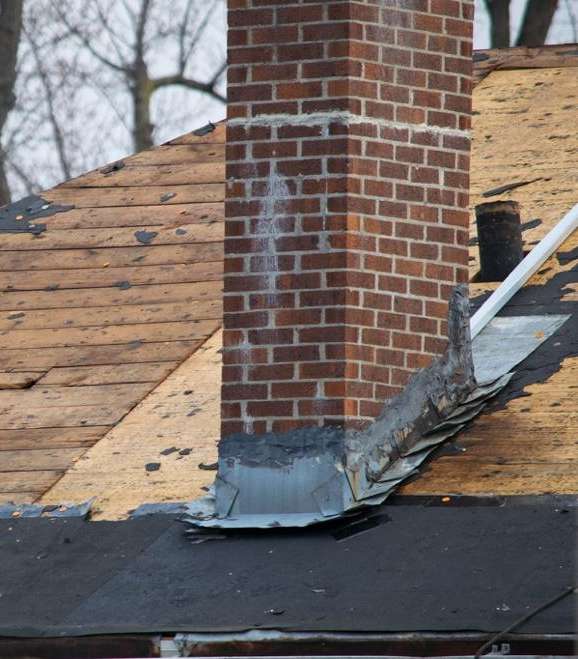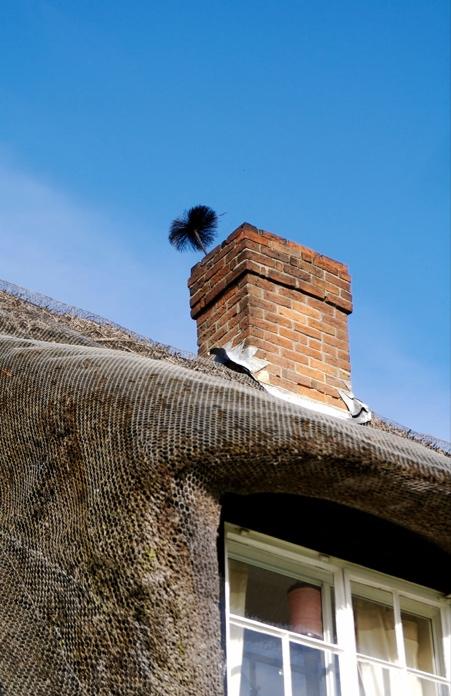While you’re enjoying the summer sunshine across Cambridgeshire, your chimney might be the last thing on your mind. But as we head towards the end of August, now is actually the perfect time to check whether your chimney needs attention before the cooler months arrive.
We get it – chimney maintenance isn’t exactly at the top of anyone’s to-do list during the warmer months. Between work, family commitments, and making the most of the brief British summer, it’s easy to forget about the flue that’s been sitting quietly above your roof. However, a quick inspection now could save you from smoke-filled rooms, costly repairs, or worse when the weather turns.
Here are five clear signs that your chimney needs professional sweeping before you light your first autumn fire.
1. White Staining on Your Chimney Exterior
Take a step outside and look up at your chimney. If you notice white, chalky staining on the brickwork – particularly common on Victorian terraces throughout Cambridge, Ely, and surrounding areas – this could indicate efflorescence. This white residue appears when water draws salts from the masonry to the surface.

While efflorescence itself isn’t dangerous, it often signals that moisture is getting into your chimney system. This moisture can mix with soot and creosote deposits, creating a corrosive paste that damages your flue lining. The combination also increases the risk of chimney fires and can lead to structural problems if left unchecked.
What you might see:
- White, powdery deposits on external brickwork
- Staining that appears after rain
- Discolouration that seems to ‘bloom’ on the surface
If you’re noticing these signs on your property in Newmarket, Royston, or anywhere within a 25-mile radius of Cambridge, it’s time for a professional inspection and sweep.
2. Strong Odours Coming from Your Fireplace
During warm weather, you might notice unpleasant smells wafting from your unused fireplace. This isn’t just an inconvenience – it’s your chimney telling you it needs attention.
When soot, creosote, and other debris build up in your flue, they can create strong, acrid odours that become more noticeable in humid conditions. These smells can permeate your living space, making rooms uncomfortable and potentially indicating a more serious problem.
The odour typically results from:
- Creosote deposits breaking down in heat and humidity
- Animal droppings or nesting materials
- Moisture mixing with accumulated soot
- Poor ventilation due to blockages
Many homeowners in Saffron Walden and St Ives have contacted us after noticing these persistent smells, often discovering that a thorough sweep and possible flue cleaning resolved the issue completely.
3. Animals or Birds in Your Chimney
It’s not uncommon to hear scratching, chirping, or rustling sounds coming from your chimney during the warmer months. Birds, squirrels, and other wildlife often see unused chimneys as perfect nesting spots, particularly in areas like Huntingdon and St Neots where properties back onto green spaces.

While it might seem harmless, animal activity in your chimney creates several problems. However, it’s important to note that it’s illegal to disturb active bird nests during nesting season (March to August), so if you suspect an active nest, you’ll need to wait until September for safe, legal removal.
Immediate concerns:
- Nesting materials can block your flue completely
- Animal droppings create health hazards and odours
- Trapped animals may die, causing severe smell and hygiene issues
- Damaged flue lining from claws and debris
Long-term risks:
- Blocked flues prevent proper ventilation
- Increased carbon monoxide risk when you use the fireplace
- Fire hazards from combustible nesting materials
If you’re hearing wildlife in your chimney, don’t attempt to remove them yourself. Professional bird nest removal ensures both the animals’ welfare and your safety, while a thorough sweep afterwards removes all traces of their occupancy.
4. Rust on Your Damper or Firebox
The damper – the metal plate that opens and closes your flue – should move freely and create a tight seal when closed. If you notice rust on the damper, firebox, or any metal components around your fireplace, this indicates moisture problems that need addressing.
Rust formation suggests:
- Poor chimney cap or crown condition
- Damaged flue lining allowing moisture penetration
- Condensation issues from previous fires
- General deterioration of chimney components
Check for these signs:
- Orange or brown discolouration on metal parts
- Damper that sticks or won’t close properly
- Flaky, corroded surfaces
- Water stains around the fireplace opening
Properties throughout Bishop’s Stortford and the surrounding villages often experience these issues, particularly older homes where original chimney components may be reaching the end of their useful life. A CCTV chimney survey can help identify the extent of any damage and determine whether sweeping alone will suffice or if repairs are needed.
5. Poor Performance During Your Last Heating Season
Think back to last autumn and winter. Did you notice any of these issues when using your fireplace or wood burner?
Smoke problems:
- Smoke entering the room instead of going up the chimney
- Difficulty getting fires to draw properly
- Smoke smell lingering in the house after fires
Efficiency issues:
- Fires burning poorly or going out frequently
- Excessive smoke production
- Difficulty maintaining consistent heat
Unusual sounds:
- Howling or whistling from the chimney
- Debris falling into the fireplace
These performance issues often indicate a partially blocked flue, excessive creosote buildup, or structural problems that have developed over time. Many homeowners assume these problems will resolve themselves, but they typically worsen without professional intervention.
Why Professional Sweeping Matters
Regular chimney sweeping isn’t just about removing soot – it’s a comprehensive safety service that protects your home and family. As Guild of Master Chimney Sweeps certified professionals, we understand that every chimney system is different, particularly given the mix of housing types across Cambridgeshire.
Professional sweeping includes:
- Complete removal of soot, creosote, and debris
- Inspection of flue condition and structural integrity
- Identification of potential problems before they become serious
- Advice on maintenance and usage
- Compliance with Building Regulations and insurance requirements
For properties with wood burners, Agas, or other solid fuel appliances, regular sweeping is essential for safe operation. HETAS registration ensures we understand the specific requirements for different appliance types and can provide appropriate maintenance schedules.
The Autumn Preparation Advantage
Booking your chimney sweep before the heating season begins offers several advantages:
Practical benefits:

- Greater availability for scheduling
- More flexible appointment times
- Time to address any issues discovered
- Ready to use your fireplace when the weather changes
Safety considerations:
- Ensures proper ventilation before first use
- Reduces fire risk from accumulated deposits
- Identifies and resolves structural problems
- Maintains carbon monoxide safety
Cost effectiveness:
- Prevents emergency callouts during busy periods
- Allows planned maintenance rather than reactive repairs
- Maintains appliance efficiency and lifespan
FAQs
How often should I have my chimney swept?
For regular use (weekly fires), annually before the heating season. For occasional use (monthly or less), every 18-24 months is typically sufficient. Wood burners and solid fuel appliances may need more frequent attention.
Can I sweep my chimney myself?
While basic cleaning is possible, professional sweeping includes safety inspections and identifies problems that untrained individuals might miss. Insurance and Building Regulations often require professional certification.
What happens if I don’t sweep my chimney regularly?
Risks include chimney fires, carbon monoxide poisoning, smoke damage to your home, structural damage from creosote buildup, and potential insurance claim issues.
Do gas fires need chimney sweeping?
Gas appliances produce different byproducts than solid fuels, but flues still require regular inspection and cleaning to remove cobwebs and debris that can block the flue. We recommend sweeping gas flues every 3 years.
How long does a chimney sweep take?
A standard sweep typically takes 30-45 minutes, depending on your chimney’s condition and any additional services required. We’ll provide a timeframe when booking.
What should I do if I think there’s an active bird nest in my chimney?
It’s illegal to disturb active nests during nesting season (March to August). If you suspect an active nest, book your appointment for September onwards when it’s safe and legal to remove nesting materials and sweep the chimney.
Why Choose Ablewight Chimney Services?
Certified Expertise As members of the Guild of Master Chimney Sweeps and HETAS registered professionals, we bring decades of combined experience to every job. Our Trading Standards approval gives you additional confidence in our work quality and business practices.
Comprehensive Service Beyond chimney sweeping, we offer CCTV chimney surveys, bird nest removal, stove servicing, and specialist treatments like Cre-away for heavy tar and creosote deposits. One call handles all your chimney needs.
Local Knowledge Based in Cambridge and covering the 25-mile radius including Ely, Newmarket, Royston, Saffron Walden, St Ives, Huntingdon, St Neots, and Bishop’s Stortford, we understand local housing types and common chimney issues in our area.
Transparent Pricing No hidden costs or surprise charges. We provide clear, upfront pricing and explain any additional work needed before proceeding.
Contact Your Local Chimney Experts
Don’t wait until the first cold snap to discover your chimney needs attention. Early autumn is the perfect time to ensure your fireplace or wood burner is ready for the months ahead.
Get in touch today:
- Phone: 01223 627012
- Email: hello@ablewight.co.uk
Service Areas: Cambridge • Ely • Newmarket • Royston • Saffron Walden • St Ives • Huntingdon • St Neots • Bishop’s Stortford • All surrounding villages within 25 miles
Certifications: Guild of Master Chimney Sweeps • HETAS Registered • Trading Standards Approved
Ready to enjoy safe, efficient fires this autumn? Contact Ablewight Chimney Services today for professional chimney sweeping and inspection services across Cambridgeshire.


